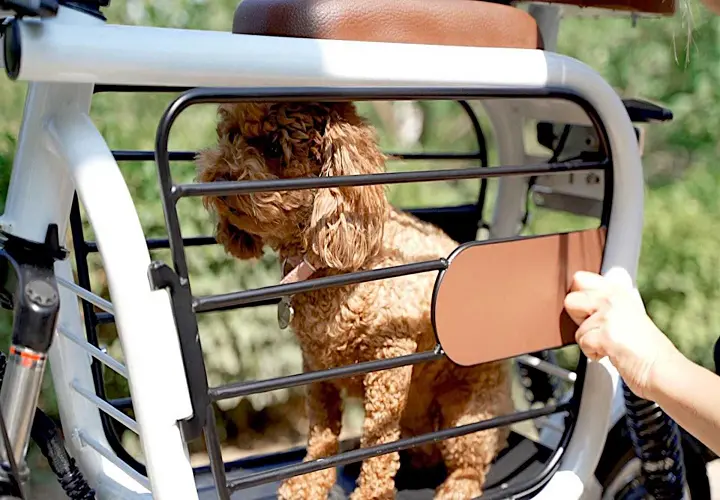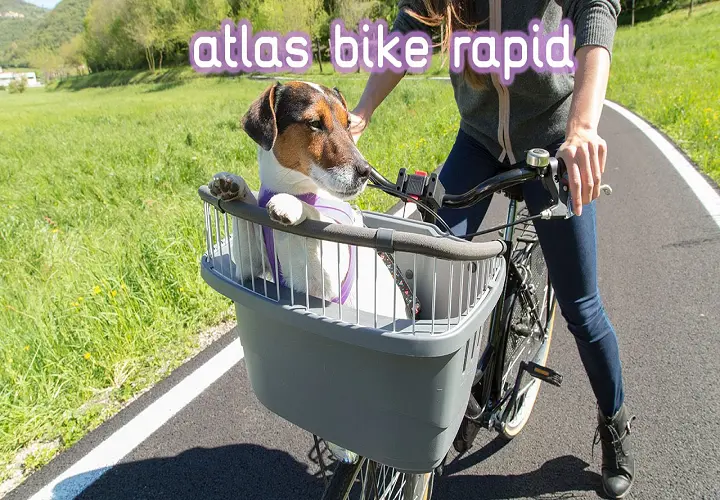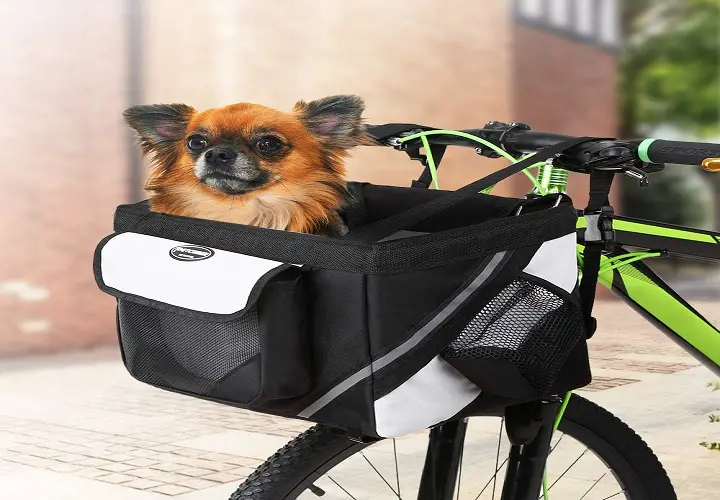Ready to transform your daily bike rides into unforgettable adventures with your furry companion?
Let’s dive deep into everything you need to know about selecting and using the perfect dog carrier for bike journeys.
From choosing the right style to training tips and safety protocols, this comprehensive guide covers it all.
Why Bike with Your Dog?
The growing trend of cycling with dogs isn’t just a passing fad. More pet parents are discovering the incredible benefits of bringing their four-legged friends along for bike rides. A quality dog carrier for bike travel opens up a world of possibilities for both you and your furry companion.
Key Benefits:
- Strengthens your bond through shared outdoor experiences
- Provides essential mental stimulation for your dog
- Makes daily exercise more engaging and enjoyable
- Perfect solution for elderly or small dogs who can’t keep up
- Great alternative when dog parks aren’t accessible
- Helps anxious dogs build confidence
- Creates opportunities for socialization
- Enables longer adventures together
“Since we started biking together, I’ve noticed a remarkable improvement in my dog’s mood and energy levels. It’s become our special time together.” – Mike R., Adventure Cyclist
Understanding Different Dog Carrier Options
Let’s explore the three main categories of dog carriers for bikes, each designed for specific needs and situations:
Handlebar-Mounted Baskets
These front-mounted carriers are ideal for small dogs weighing under 15 pounds, keeping them close where you can monitor their reactions and comfort level.
Pros:
- Direct visibility of your pet
- Easy communication during rides
- Simple installation process
- Compact design for city riding
- Quick access to your dog
- Perfect for short trips
- Lightweight construction
- Usually more affordable
Cons:
- Limited to small dogs only
- Can affect steering and balance
- Less protection from weather
- Limited storage space
- May require additional stabilization
- Not suitable for rough terrain
Real-World Example: Sarah Jenkins, a urban cyclist in Portland, uses a handlebar basket for her 8-pound Maltese. “The front mounting lets me keep an eye on Luna and adjust quickly if she seems uncomfortable. We’ve logged over 500 miles together this way!”
Rear-Mounted Carriers
These sturdy carriers attach to your bike’s rear rack and accommodate dogs up to 25 pounds, offering better weight distribution and stability.
Key Features:
- Robust platform design
- Multiple secure attachment points
- Better overall balance
- Optional weather protection
- Integrated storage pockets
- Reflective safety elements
- Quick-release mechanisms
- Adjustable safety tethers
Installation Tips:
- Ensure your bike rack can support the combined weight
- Check all mounting points before each ride
- Test stability before adding your dog
- Double-check quick-release mechanisms
- Verify rack compatibility with your bike frame
Bike Trailers
The most versatile option for dog carriers for bikes, trailers can handle larger breeds up to 100 pounds while providing superior comfort and protection.
Benefits:
- Spacious interior for movement
- Excellent stability on various terrains
- Complete weather protection
- Additional storage for gear
- Multi-use capabilities
- Better shock absorption
- Suitable for longer journeys
- Can accommodate multiple small dogs
Popular Uses:
- Weekend camping trips
- Beach adventures
- Trail exploration
- City errands
- Veterinary visits
- Park excursions
- Long-distance touring
Critical Safety Features

When selecting a dog carrier for bike rides, safety should be your primary consideration. Here’s a detailed breakdown of essential features:
| Feature | Purpose | Must-Have Elements |
| Attachment System | Prevents separation | Multiple connection points, backup safety straps |
| Ventilation | Temperature control | Mesh panels, adjustable openings, air flow design |
| Safety Tethers | Secures dog | Adjustable length, quick-release clips, sturdy anchors |
| Reflective Elements | Night visibility | 360-degree reflective strips, LED attachment points |
| Weather Protection | Environmental shield | Water-resistant materials, UV protection, ventilation |
| Padding | Comfort & protection | High-density foam, washable covers, impact absorption |
| Frame Structure | Structural integrity | Aluminum or steel frame, reinforced corners |
| Entry/Exit Points | Easy access | Wide openings, stable platform, non-slip surface |
Comprehensive Sizing Guide
Getting the perfect fit is crucial for your dog’s safety and comfort. Follow these detailed measurements:
Essential Measurements:
- Length: Measure from chest to tail base
- Height: Floor to top of head when sitting
- Weight: Current weight plus 2-3 pounds for gear
- Chest: Widest part of ribcage
- Neck: Around the thickest part
- Shoulder height: Floor to top of shoulders
- Standing height: Floor to top of head
Size Chart Guidelines:
Small Dogs (up to 15 lbs)
- Ideal for handlebar baskets
- Maximum carrier dimensions: 12″L x 10″W x 10″H
- Weight capacity: 15 lbs
- Best for: Chihuahuas, Yorkies, Toy Poodles
Medium Dogs (15-25 lbs)
- Suited for rear carriers
- Maximum carrier dimensions: 20″L x 15″W x 15″H
- Weight capacity: 25 lbs
- Best for: Beagles, Pugs, Small Terriers
Large Dogs (25+ lbs)
- Requires bike trailers
- Maximum carrier dimensions: 32″L x 24″W x 20″H
- Weight capacity: 100 lbs
- Best for: Labradors, Golden Retrievers, German Shepherds
Comprehensive Training Protocol
Successfully introducing your dog to their bike carrier requires patience, consistency, and positive reinforcement. Here’s a detailed, week-by-week training plan:
Week 1: Introduction Phase
Day 1-3: Carrier Familiarization
- Place carrier in living space
- Add familiar bedding and toys
- Reward any positive interaction
- Feed treats near the carrier
- Let dog explore at their pace
Day 4-7: Basic Commands
- Introduce “up” and “stay” commands
- Practice entering/exiting
- Reward calm behavior
- Extended periods inside carrier
- Begin harness training
“The key is making the carrier their happy place first. We spent a full week just getting comfortable with it in our living room.” – Professional Dog Trainer Lisa Martinez
Week 2: Stationary Training
Morning Sessions:
- 5-minute sitting periods
- Gradual increase to 15 minutes
- Practice safety harness use
- Treat rewards for calm behavior
Evening Sessions:
- Carrier attachment to bike
- Stationary comfort building
- Environmental awareness
- Positive association building
Week 3: Movement Integration
Controlled Environment Practice:
- Empty parking lots
- Quiet residential streets
- Private driveways
- Park paths during off-hours
Progressive Steps:
- Walking bike slowly (5-10 minutes)
- Gentle pedaling (10-15 minutes)
- Normal riding speed (15-20 minutes)
- Various terrain introduction
Product Recommendations
Based on extensive research and user feedback, here are top picks for different scenarios:
Best Handlebar Carriers
Premium Option: K9 Sport Sack Rover
- Price: $189.99
- Weight limit: 15 lbs
- Key features: Aircraft-grade aluminum frame, waterproof material
- Best for: Daily commuters
Budget-Friendly: PetSafe Happy Ride
- Price: $89.99
- Weight limit: 12 lbs
- Key features: Quick-release mounting, washable liner
- Best for: Occasional riders
Top Rear-Mounted Carriers
Luxury Pick: Ruffwear Commuter
- Price: $249.99
- Weight limit: 25 lbs
- Features: Aluminum frame, suspension system
- Ideal for: Serious cyclists
Value Choice: Kurgo Carrier
- Price: $159.99
- Weight limit: 20 lbs
- Features: Water-resistant, reflective trim
- Perfect for: Regular use
Premium Bike Trailers
High-End: Burley Tail Wagon
- Price: $399.99
- Weight limit: 100 lbs
- Features: All-weather cover, removable floor
- Best for: Large dogs, long trips
Mid-Range: Schwinn Rascal
- Price: $269.99
- Weight limit: 85 lbs
- Features: Folding frame, universal coupler
- Ideal for: Weekend warriors
Safety Guidelines & Best Practices
Pre-Ride Checklist
Equipment Inspection:
- All attachment points secure
- Safety tethers in good condition
- Reflectors clean and visible
- Tire pressure optimal
- Weather protection ready
- Ventilation panels clear
- Emergency supplies packed
Dog Preparation:
- Fresh water available
- Recent bathroom break
- Harness properly fitted
- ID tags current
- Temperature appropriate
- Rest period planned
Weather Considerations
Temperature Guidelines:
- Below 45°F: Additional warming layer needed
- 45-75°F: Ideal riding conditions
- Above 75°F: Extra hydration required
- Above 85°F: Consider rescheduling
Weather Protection:
- Rain covers for unexpected showers
- Sun shields for hot days
- Cooling mats for summer
- Insulated pads for winter
Maintenance and Care
Weekly Maintenance
Carrier Cleaning:
- Remove loose debris
- Wipe down surfaces
- Check for wear points
- Inspect stitching
- Clean ventilation mesh
Hardware Check:
- Tighten loose bolts
- Lubricate moving parts
- Check attachment points
- Inspect safety features
- Test quick-release mechanisms
Monthly Maintenance
Deep Cleaning Protocol:
- Disassemble where possible
- Machine wash appropriate parts
- Hand clean non-washable areas
- Inspect for damage
- Apply protective treatments
Common Mistakes to Avoid
Setup Errors:
- Incorrect size selection
- Poor weight distribution
- Inadequate attachment
- Missing safety features
- Improper harness fitting
Training Mistakes:
- Rushing the process
- Skipping safety steps
- Ignoring dog’s signals
- Inconsistent rewards
- Too much too soon
Expert Tips and Tricks
For Better Rides:
- Start early morning or late evening
- Choose less crowded routes
- Plan rest stops every 30 minutes
- Carry emergency supplies
- Monitor dog’s behavior
- Stay within comfortable limits
For Longer Trips:
- Pack collapsible water bowls
- Bring cooling towels
- Include first-aid supplies
- Plan emergency exits
- Know vet locations
- Carry basic tools
Community Resources
Online Support:
- Facebook Groups for Cycling Dog Parents
- Local Meetup Groups
- Training Forums
- Equipment Reviews
- Route Planning Apps
Local Resources:
- Bike Shops with Pet Expertise
- Dog-Friendly Trail Maps
- Training Classes
- Veterinary Services
- Pet First Aid Courses
Conclusion
Choosing the right dog carrier for bike adventures opens up a world of possibilities for you and your furry friend.
Remember to prioritize safety, take training slowly, and always listen to your dog’s cues. With proper preparation and the right equipment, you’ll be creating wonderful memories together on two wheels.
Ready to start your biking adventure with your dog? Begin with the sizing guide, choose your carrier type, and follow our training protocol for the best experience. Happy trails!

With over 9 years of dedicated experience in the automotive industry, I am passionate about all things automotive. My journey began with a deep curiosity for automobiles, which led me to delve deeper into their mechanics, technology and trends. My expertise spans various aspects of the automotive world, from the latest electric vehicles to classic car restoration techniques. Through my articles, I aim to share my knowledge and insights, helping readers stay informed and inspired in the fast-paced world of the automobile.












